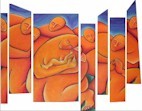| |
DVD - digital versatile
disc - click
for definitions
Older Medium explained:
CD-R media have two layers: a
reflective layer and a dye layer. When the CD writer burns the data,
the reflective layer and the dye layer melt together to form the layer that
is read by the laser
Different chemicals are
used to create that dye layer, depending on the manufacturer and the product
line. Many people incorrectly assume that the color of the CD-R media
makes no difference at all. The chemical used does have an effect on
the recording.
CD-R media with a gold reflective layer and gold dye
layer work better in drives that use a longer laser pulse when burning.
Gold-gold media is less likely to work in a variety of drives.
A gold reflective layer and green dye layer (the
original design and the industry standard) is more tolerant, has a rated
life span of 10 years and works best in drives that use a shorter laser
pulse.
The media with a silver reflective layer and a blue
dye layer is similar to the gold-green, but has a rated life span of 100
years.
A more tolerant media (silver-blue) works best with a
shorter laser pulse writer. It is good for long-term archiving. Before
you switch to a gold-gold media just on the basis of cost, you need to
consider the implications of the shorter life span, and you need to run
tests to see if the less-tolerant desks will work on your writer.
It is incorrect to say that the color is meaningless,
or that silver-blue is the only color that will work on a particular
CD-Writer. The driver for the CD Writer is irrelevant because it
will not have an impact on the laser pulse used or the archivability of the
CD. You may be able to switch, but testing needs to be done first.
|

